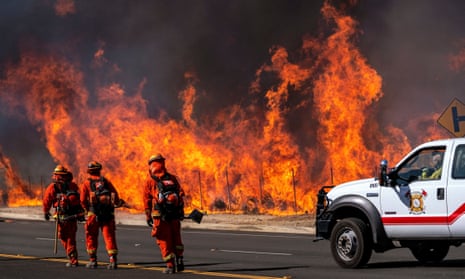The wildfires burning across California have put a national spotlight on the incarcerated firefighters the state depends on to fight these blazes.
But while state leaders scramble to backfill vacant positions on the firefighting lines, it’s important to remember the backdrop that helped create the crisis in the first place. This is the result of policies that value the preservation of cheap labor over a system that benefits communities and offers incarcerated individuals a path to freedom and a fair shot at employment.
As a formerly incarcerated person at the Central California Women’s Prison, I spent two and a half years fighting wildland fires, responding to car crashes, and rushing to homes to extinguish blazes. There, I was trained to use the jaws of life tool to extricate victims from mangled cars. I learned to battle brush and structure fires and ran into harm’s way while keeping my crew members safe.
When the car carrying the daughter and grandchild of a correctional officer ran off the road and into the almond orchards surrounding our prison, it was my crew and I who responded to the scene. As we prepped the baby for airlift, I was moved to have a small child in my arms after so long away from my own kids.
On Christmas Eve, when the home of another correctional officer caught fire, we rushed into the house, bringing out photographs and presents so the family could have their holiday.
I am proud to have served on my firefighting crew – the experience gave me a chance to grow as a person and a first responder. As a lead engineer, I earned 37 cents an hour: $56 a month. I didn’t fight fires for the money. I didn’t do it to have additional time shaved off my sentence, which I wasn’t eligible for because of my crimes. I did it because it made me feel like I was contributing to my state and a part of the community around me.
Unfortunately, despite my training, experience and the fact prison officials determined I was safe to help save lives in the community, I had no realistic path to the same work after I was released. Travel limitations attached to my parole meant one of the few routes to regular firefighting work – seasonal employment with Cal Fire – was closed to me.
Lawmakers have allowed the situation to continue. Legislative efforts to reduce barriers to licensing and certification faced by formerly incarcerated people have fallen short.
Six years before Kamala Harris became the first woman of color on a major ticket, while she served as California’s attorney general, her office repeatedly thwarted efforts to reduce overcrowding in prisons. At one point it argued that the early release of inmates “would severely impact fire camp participation — a dangerous outcome while California is in the middle of a difficult fire season and severe drought”.
The very efforts to reduce prison populations that prompted this response from Harris are the reason I, as someone convicted of a crime considered serious and violent, was allowed to serve on the fire crew to begin with. After the state implemented changes that would mean fewer people moving from the county jail to state prisons, corrections officials expanded the criteria that allowed someone to serve on fire crews, opening up the pathway to people convicted of more serious crimes.
That’s not to say that entrance to fire crews is a given. In order to get approval, I needed to go before an internal committee to make a case that I deserved a chance to fight fires. The committee considered all of my crimes, my behavior behind bars and the recommendations from counselors before deciding I was safe to work in the community.
And yet, despite the vetting and votes of confidence that establishes us as safe to respond to emergencies, the same logic isn’t applied to us as individuals. In other words, if we’re safe to serve our community, how can we not be safe to live there?
The history of California’s prisons, and how state officials have responded to swelling prison populations, have made clear the decision comes down to the reality that we represent cheap labor – and that’s more important to lawmakers than the state’s commitment to reduce overcrowding.
I call on state lawmakers to release incarcerated people who have been deemed safe to work in the community, sparing them from the virus devastating prison populations. I ask them to provide a pathway to work after their release. I call on state leaders to do what’s right and back up their stated commitment to racial and social justice with action.
Amika Mota serves as the statewide policy director at the Young Women’s Freedom Center
This article was amended on 3 September 2020 to change the wording of the standfirst, which in an earlier version implied there was no pathway to work as a firefighter in California for prisoners after release.
